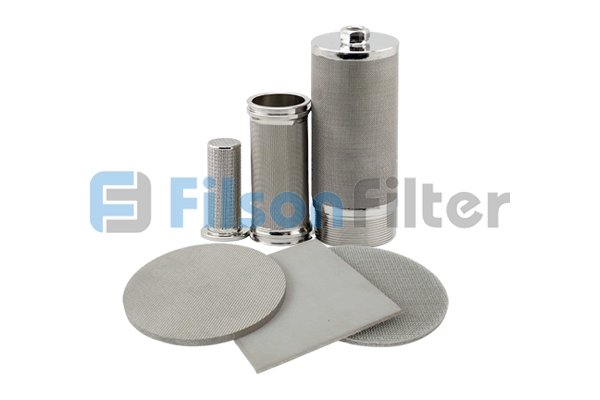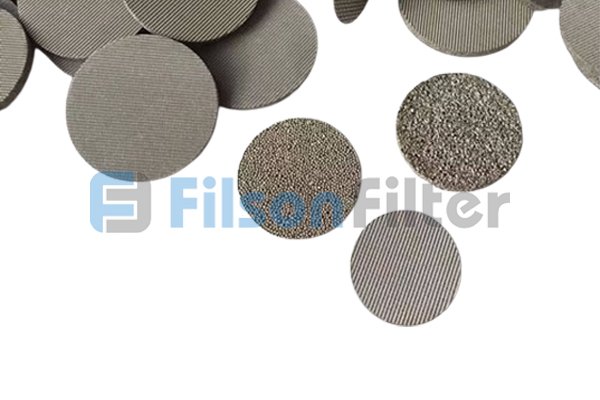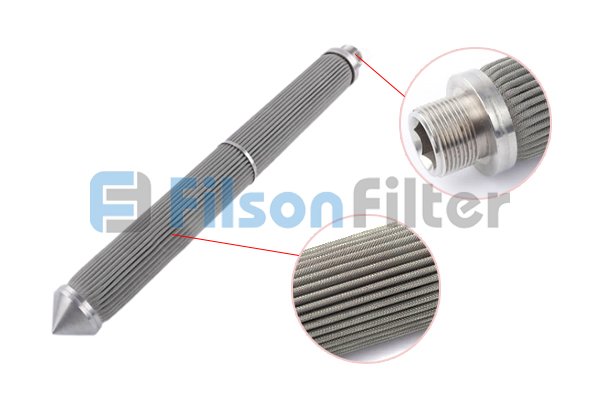Filson Sintered Mesh Filter
- Micron-rated aperture for fine filtration and better performance
- Good mechanical strength and stability due to advanced sintering technology
- Multi-layer sintered mesh selection fitting your applications
- Available to be engineered into various sintered filter elements
- Quality raw material to ensure the long-lasting of the end product
- Specifications
- Send Us Inquiry
Filson has been exploring in filtration field for more than 20 years and integrated the global cutting edge technologies to manufacture the sintered mesh filters. Among these, stainless steel sintered mesh filter is the most popular product in the market.
- Construction material: stainless steel ( 304, 316, 316L, 904L ), monel, hastelloy, nickel, aluminum, brass, bronze, copper, carbon steel
- Layer: single, 2 to 3, 5-layer, 6-layer or custom
- Operating Temperature: -200℃- 600℃ ( upon material and request )
- Filtration rating: 1 – 250μm
- Filtration efficiency: up to 99.98%
- Connection type: 222, 226, SOE, DOE
- Shape: disc, cylinder, sheet, plate, cone, screen, basket
Note: specifications listed above are for reference only, more details are to be known by consulting Filson.
Send Your Inquiry Today
Filson Sintered Mesh Filter
Your Reliable Sintered Mesh Filter Supplier in China
Filson sintered mesh filter is a versatile device used in almost all sorts of industrial applications, including chemicals, pharmaceuticals, oil & gas production, food and beverage, aerospace, and refining, playing an important role in filtration.
As it’s shown above, Filson sintered mesh filter is fully customizable based on customer specifications. Usually, it is made of stainless steel, monel, nickel, carbon steel, and many other metal materials and alloys.
Under the support of quality materials and a strictly controlled sintering process, Filson sintered mesh filter is endowed with numerous outstanding properties, such as high temperature and corrosion resistance, excellent mechanical strength, a wide range of filtration rating, and high filtration efficiency up to 99.98%.
Typically, Filson sintered mesh filter is designed and manufactured with a single layer or multi-layer metal meshes, of course, under a vacuum sintering condition with a particular temperature. You can choose the mesh layer according to your actual needs. ( 5-layer sintered mesh filter for standard )
Besides, determined by your application needs and equipment connected with the filter, you are allowed to choose Filson sintered mesh filter in different shapes and types. No matter for a sintered mesh filtre disc or a sintered mesh filter cartridge, Filson can provide for you.
If you are looking for an ideal sintered metal mesh filter, do not miss Filson today!
Contact us:
Tel: 86 – 157 3695 8886
Email: sales@filsonfilters.com
Sintered Mesh Filter: The Ultimate FAQ Guide
This guide covers everything you need to know about sintered mesh filter.
From the basic definition, structure, working principle to specifications, among other critical aspects.
So, if you want to be an expert in sintered mesh filter, read this guide
What is Sintered Mesh Filter?
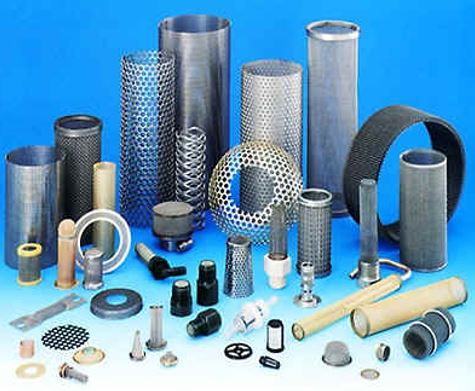
Types of Sintered Mesh Filter
This is a filtering material made of one or many layers of woven wire mesh.
The woven wire mesh is pressed or sintered in making the filter element.
Normally, the mesh filter could have even up to 8 layers of the sintered wire mesh.
However, averagely most sintered mesh filters have five layers.
The different layers of wire mesh determine the filter rating, dimension and shapes.
Some of the common shapes of sintered mesh filter are:
- Filter baskets
- Filter plates
- Cone-shape
- Cup filters
The sintered mesh filter also has a protective mesh layer, filter mesh layer, and another protective mesh layer on the outer side.
These sections make the mesh filter firm and durable.
How Does Sintered Mesh Filter work?
The filtration process is dependent on the process fluid being filtered. However, it creates a physical barrier between the impurities and the process fluid of choice.
For instance, during the removal of gas and vapor from pharmaceutical powderly products; the gas passes through the mesh filter.
The contaminants are trapped on the mesh filter by the adhesive force between the particles and they form a cake.
The cake is held in place further by the gases passing through the filter.
During the removal of the powder, a reverse flow of the gas is done to dislodge the impurities from the filter.
How Do You Manufacture Sintered Mesh Filter?

Layers of Mesh Sintered Filter
To make the sintered wire mesh, you use a single uniformly woven wire mesh and press it with an industrial roller under high pressure.
The flattening is done to increase contact with the additional layers.
You will then laminate the woven wire mesh in a furnace at heavy mechanical weight and temperature.
Lamination is done using a courser protective layer.
You can do lamination singly, or with multiple wires mesh.
The furnace uses inert gases at high temperatures enough to cause diffusion bonding (sintering).
You can sinter your mesh filter using a sheet or coil.
This you do to create a permanent bond between the wire intersections.
The decision to choose between sheet sinter and coil sinter is application dependent.
In an application characterized by high pressure, you might consider using a sheet sinter. However, in applications sensitive to loose wires and deep drawing, you will need to sue coil sinters.
By sintering, you increase the contact level of different layers or wire mesh enabling you to achieve a high filtration efficiency.
Additionally, you can make a wire mesh that is handy in withstanding high pressure.
Otherwise, the wire loop may disintegrate.
The high mechanical strength, malleability, and durability you create in a wire mesh through sintering, increases your diversity in the utilization of the wire mesh.
Therefore, the wires and the several layers of the wire mesh becomes bonded.
You should allow the sintered wire mesh to cool in a controlled environment so that you can achieve the desired characteristics.
The sintered wire mesh formed is usually rigid and very flat.
Thereafter, the sintered wire mesh is cleaned, inspected against the quality standards, and certified.
The sintered wire mesh is made into different specifications of size, filtering rates, and shapes. You can also weld, pleat, or roll into different shapes.
These characteristics enable you to use the sintered wire mesh in discs, candles, cartridges, and cylinders.
Otherwise, non-sintered wire mesh may not be malleable in all these.
Which Impurities are Removed by Sintered Mesh Filter?
The type of impurity to be removed is highly dependent on the application of the mesh filter. Some of the impurities include; solid particles from liquid or gas,
Which are the Different Ways of Weaving a Sintered Mesh Filter?
You have the various option of weaving a wire mesh as below;
· Plain Sintered Square Weave
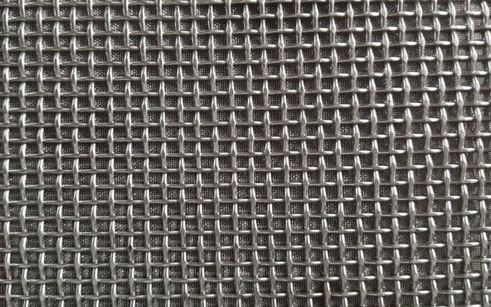
Plain sintered Square Weave
You can make this type of wire mesh by sintering several layers of plain square weave mesh. Square mesh has got an opening that one can see through.
However, the square mesh is not durable in making filtration products.
Besides, it is not possible for you to bend or mold while maintaining its integrity of shape and other quality characteristics.
Therefore, for you to achieve the desired filtration level, you need to sinter several layers of the plain square weave.
You can add as many layers as your prefer.
The thick sintered square weave can be used as a detonator and frame preventer.
You are likely to find this type of sintered wire mesh in air and fluid filtration.
Despite the thickness, the filter has excellent permeability and low flow due to its large opening area percentage.
Therefore, you would still achieve high flow characteristics.
Other characteristics of this type of filter include;
- Filter rating of (1µm-300µm)
- Size (500*1000mm, 600*1200mm, 1000*1000mm)
- Alloys used (SUS 304, 316, 316L)
- Weight (8KG/m2 , ).
· Sintered Dutch Weave Mesh
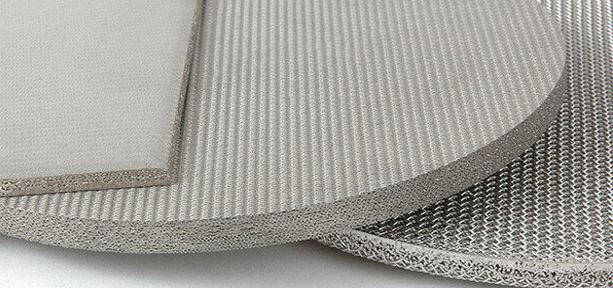
Sintered Dutch Weave Mesh
You can achieve this type of sintered wire mesh by sintering 2-3 layers of standard dutch weave meshes.
This type of sintered weave mesh is characterized by being strong mechanically, evenly spaced open mouth, and low permeability.
It is mostly made of stainless steel wire mesh but occasionally, other alloys may be used.
This type of mesh filter is used in; transporting powders, gas filtration, coolers production, laboratory filters, liquid filtration, drivers manufacturing, pharmaceutical filtration, chemical filtration, and laboratory fluid beds.
· Perforated Metal Sintered Wire Mesh
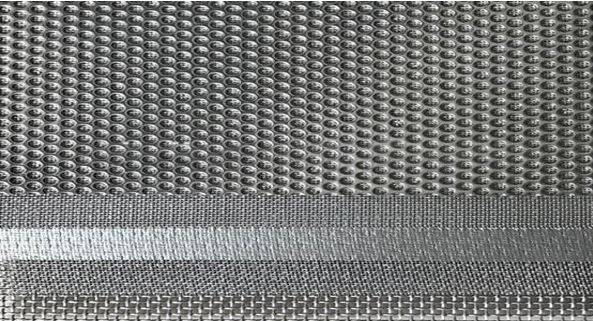
Perforated Metal Sintered Wire Mesh
This type of sintered wire mesh is made by sintering a perforated plate layer and several woven wire mesh.
The perforated plate should be the base.
Additionally, the perorated plate acts as a mechanical supporter and makes it easy to handle the filter during sintering.
You can achieve different filtration rates using adding several layers of grinding weave to the perforated metal sintered wire mesh.
You may prefer this form of wire mesh because;
- High mechanical strength
- Easy to clean and reuse
- High resistance to heat and corrosion
- Filter rating of 1µm – 200µm.
You are most likely to find it in food and beverage industries, polymer production, pharmaceuticals industries, waste treatment, and dust removal.
· Sintered Wire Mesh
This is composed of five layers of woven wire mesh.
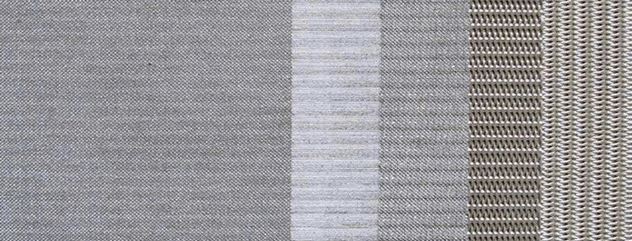
Sintered Wire Mesh
It is achieved by sintering woven wire mesh at the contact points at high temperatures and pressure.
A fine woven mesh is placed between four layers of Dutch woven wire mesh, two on each side. All five layers are sintered together to form a strong sintered wire mesh.
You could customize the filtration rating of the sintered wire mesh to your specifications. The ratings could be between 2µm to 200 µm.
Where can you use Sintered Mesh Filter?
Sintered wire mesh filter has varied utilization.
Some of the filtration processes you can use the sintered wire mesh include; powder fluidization, chromatography frits, slurry oil filtration, nutsche filter, and steam filtration.
Some of the industrialization utilization of the sintered wire mesh you can consider include;
- Polymer filtration in the manufacture of synthetic fibers, processing films, and spin packs.
- In the food and beverage industry, you can use the sintered wire mesh filter in filtering flour, impurities, sewage, and milk powder.
- In the Aerospace industry, you can utilize the sintered wire mesh in constructing a hydraulic filter, noise abatements, and lubricating oil filter.
- You can utilize the Sintered wire mesh filter in filtering hot gases, corrosive liquids, and recovering catalysts in petrochemical and refining industries.
- Pharmaceutical industries utilize it in the manufacturing of scrubbing and drying units, medical filter plates, and drug purification
- In the production of gas and oil filtration, you can utilize the sintered wire mesh to construct sand control wire mesh, backwash filters, and flame retardant filters.
What are the Features of Sintered Mesh Filter?
You should ensure that your sintered wire mesh filter measures the following qualities;
- It should be able to withstand high temperature and pressure.
This is also the main reason why it is manufactured at high pressure and temperature.
Therefore, your filter mesh should not disentangle under similar conditions. - It should resist chemical reactions with the fluid process.
Meaning it should not corrode, oxidize nor should abrasion occur. - The sintered mesh filter should be strong mechanically.
This is also because most of its applications would be under high pressure otherwise, it would be damaged. - The sintered wire mesh should be easy to clean and reuse.
This is because, unlike many filters, it would be used for a long time without the need to replace. - After the sintering process, the sintered wire mesh should be easy to mechanize to fit into different uses.
Therefore, it should be easy to punch, fabricate, shear, or weld. - Your sintered wire mesh should be able to be developed into different filtration ratings.
This is to enable it to fit in the different applications of varying filtration rating requirements. - Your sintered wire mesh should have the possibility to customize it to different applications.
- Your sintered wire mesh should be economical in terms of dimension.
What Materials are used to make Sintered Mesh Filter?
Stainless steel: This generally describes all steel alloys with chromium levels of ≥ 10.5%.
This increases its resistance to corrosion in comparison to plain steel.
Chromium oxidizes on exposure to the environment to form a chromium oxide protective layer. The layer is extremely thin and invisible.
Also, the same oxidation process happens whenever the stainless steel is exposed protecting the metal from corrosion.
Among the stainless steel alloy T-304 and T-316 are the most common alloys you will find making the mesh wire.
It is strong and handy and can be utilized in making a sub-micron mesh filter.
Besides, it can maintain its high filter rating at high pressure.
It is also able to withstand high temperatures (1500 °F).
This characteristic enables its utilization in; diffuser screens, fluidized beds, centrifuges, chromatography, breather vents, nutsche and hydraulic filters.
Specific examples of stainless steel you can use include;
Stainless steel 904L: It has a very high resistance to rusting and corrosion.
Therefore, it is the most ideal in use in moist corrosive places like in the seawater.
Stainless steel 316 SS: It has molybdenum making it resistant to corrosive chemicals. Particularly, it can resist pitting and crevice corrosion in a warm chloride environment.
It has similar qualities as stainless steel 304 but some environmental conditions demand its utilization instead of stainless steel 304.
It is also considered as the standard alloy and the most second used alloy.
Its advantageous characteristics make it is ideal for use in a wide range of applications. Therefore, you could utilize this mesh filter in industrial chemical industries that manufactures corrosive chemicals.
Stainless Steel 304 SS: It is the most used alloy that has a high resistance to oxidation at high temperatures (1600oF intermittent service and 1700oF in continuous operation) and corrosion. This makes it the best choice in similar conditions.
It is easy to fabricate through cutting, shaping, and welding into preferred forms.
Additionally, it is non-magnetic in the annealed condition. It is also the most well-priced alloy of stainless steel.
Stainless steel 304L: Although it has a low carbon concentration in comparison to 304SS it has similar characteristics with it in addition to increased weldability.
The 304 stainless steel contains ≥ 18% chromium and ≥8% nickel in addition to small traces of carbon and Mn.
In addition to their high resistance, they are non-magnetic.
Stainless steel 316L: It has reduced carbon concentration in comparison to 316SS.
Its characteristics are similar to 316SS but it has higher weldability.
T-310 SS – This is a customized alloy of steel.
It has resistance to high temperature, good ductility, toughness, and good welding properties.
Besides, it is specifically used in very high temperatures.
There are more customized alloys of the steel depending on the intended application.
Monel: It has anticorrosive properties making it ideal for you to use in a highly corrosive environment.
Nickel: It is ideal for use in corrosive environments like organic acids, caustics, and chemicals.
Aluminum: Aluminum is cheap and lighter than most metals yet strong.
This makes aluminum the most ideal in applications requiring strong and light materials e.g. in the HVAC system and personal electronics.
The most common aluminum alloy is 5052.
Brass: It is a soft and malleable alloy of copper and zinc.
In comparison to copper, it gives more tensile strength and resistance.
It mostly found in 2 variations; 270 yellow brass (65% Cu+35% Zn.) and 260 high brass (70% Cu+ 30% Zn). Its attractive color makes it preferred in making decorations.
Bronze: is also an alloy of copper and zinc but the copper concentration are higher (90%) in comparison with brass.
Other ingredients may also be added for various reasons.
Its high strength and resistance enable its utilization in a filtration process requiring higher durability.
Copper: In addition to being used on making mesh filters it is mostly preferred in being used in architecture and art.
Plain/ Carbon Steel: it is composed mainly of Fe and a small proportion of C.
It is widely used in window guard, fireplace screens, shaker screens, gravel, and stone separation during the mining of coal.
To increase its resistance to rusting, you may consider coating it with galvanizing, paint, powder coating, or PVC.
However, the coating process is done after making the mesh.
Among the options you have for making the mesh wire, stainless steel is the most preferred. This is because it is possible to manufacture versatile and robust equipment using stainless steel.
Its high resistance to high temperatures, corrosion, oxidation, mechanical and hydraulic pressure.
This makes stainless steel to be the most ideal in different applications.
Additionally, during the sintering process, you will not need to add fillers, alloys, or bonding agents.
How Many Layers Should a Sintered Mesh Filter have?
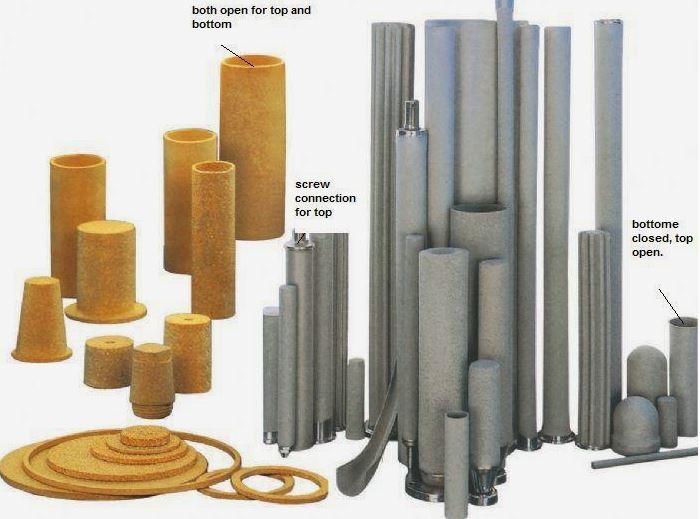
Sintered Metal Filters
The limitation of the layer to use will depend on your intended use of the sintered metal filter and the filtration rate expected.
Averagely, the sintered wire mesh filter mostly consists of five layers but occasionally it may contain 6-8layers.
When you make a multilayer, you will have several benefits among them being;
- You will have the desired micron filtration while maintaining the intended mechanical strength of the wire mesh.
- It is easier to clean a multilayered wire mesh since it does not allow backwash pressure.
- Regardless of the operational pressure, the wire mesh can maintain mechanical integrity and the filter rating.
What are the Characteristics of Different Layered Sintered Mesh Filter?
The characteristic will largely depend on the number of layers in each mesh filter.
· Single Layer;
The diffusion bonding effectiveness makes this type of mesh filter to have a permanent filter rating, dimensions, and pore size.
Making this type of filter does not require sealing and it is cheaper than other types of wire mesh.
You can have this type of wire mesh fabricated as cylinders, rings, or discs.
· Duo/ Tripped Layered Sintered Wire Mesh
This type of wire mesh has got a filtered layer in between the protection layer.
The protection layers could be on either side or both.
· Five Layered Sintered Wire Mesh
The filtration layer is sandwiched between a protective layer and a supportive layer on both sides.
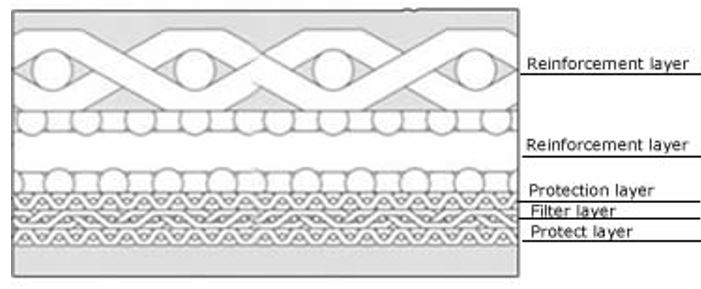
Five Layered Sintered Wire Mesh
This type of mesh becomes very strong mechanically being able to withstand pressure.
Also, this type of mesh wire is ideal in industrial applications with similar conditions.
· Six Layered Sintered Wire Mesh
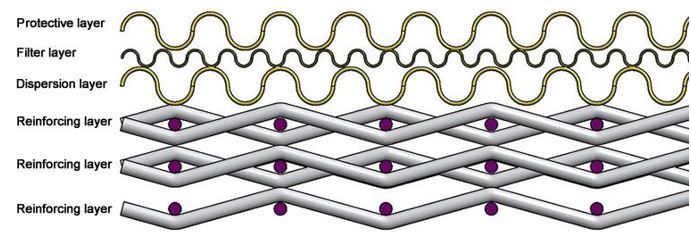
Wired mesh filter
It is similar to the five-layered sintered wire mesh but it has a drainage layer. This allows it to handle large quantities.
What are the Advantages of using Sintered Mesh Filter in Comparison to Traditional Wire Mesh?
The Sintered mesh filter is more advantageous in comparison to other wire mesh by;
- The sintering process makes it rigid and hardy.
Therefore, it can resist deformation and damaging forces.
Unlike the traditional wire mesh which has a loose structure making it prone to deformation and breaking. - With the Sintered mesh filter, you can get the targeted uniform pore sizes hence you can achieve the desired filtration rating.
The traditional wire mesh has non-uniform pore sizes making it hard to get the specific filtration rating. - The sintered mesh filter has increased permeability in comparison to the traditional wire mesh.
- The sintered mesh filter has enhanced mechanical strength giving it rigidity to resist destruction.
Therefore, it can have long service lifesaving you on cost.
However, the traditional mesh wire is less rigid toward pressure and other forces. Hence, it gets destroyed fast. - Multi-layering through sintering increases the mechanical strength of the sintered mesh filter.
The traditional mesh wire has got only one layer.
Therefore, it cannot be utilized in harsh conditions. - The traditional wire has a loose ending which over time, the mesh wire becomes destroyed.
Contrastingly, the sintered mesh filter is fabricated into different shapes to suit its applications.
The filter is also not left with any loose ends. Therefore, the sintered mesh filter has increased durability.
Why should you Laminate a Sintered Mesh Filter?
Lamination is done to the fine mesh wire to increase its strength and thickness.
Lamination is done to provide enough strength and protection to the fine wire mesh that is prone to destruction.
Through lamination, you can maintain the integrity of the fine wire mesh.
How do you Clean Sintered Mesh Filter?
Physical and chemical cleaning methods are the most common way of cleaning the sintered wire mesh you can adopt.
Chemical cleaning involves using dilute alkali or acid, oxidizers, or surfactants.
During physical cleaning, you will be required to use an ultrasonic cleaning machine or backlashing with cleaning gas or cleaning liquid recoil.
Backwashing involves using an inert gas like nitrogen in the opposite direction of the normal filtration process.
The ultrasonic cleaning method involves using ultrasonic waves.
Besides, the waves can be continuously pressurized and expanded to form air pockets in liquids that are continuously broken.
Resultantly, the surfaces become clean.
Your choice of cleaning methodology will depend on the type of contamination.
Characteristics of the construction material and the characteristics of the contaminants.
The specific application of the cleaning methods include;
Decarbonization filtration: mostly used in the pharmaceutical and chemical industries. Backwashing in combination with ultrasonic cleaning is used.
Water processing industry: The filter is soaked in 5% nitric acid to remove the water-insoluble salts.
Raw liquid industry: several methods can be used in combination.
Alkaline washing, pickling, and surfactant cleaning are used.
Alkaline washing involves soaking the filters in 3-5% sodium hydroxide solution for at least ≥30≤60 minutes at 40⁰C.
Rinsing should be done using deionized water to neutralize.
Drying of the filter should be done using dry air at ≥ 0.4MPa pressure.
Pickling involves soaking the filter in 5% nitric acid > 8hrs at 40⁰C. drying and rinsing are similar to alkaline washing.
Surfactant washing aims at removing organic substances. Mostly utilized in the food and beverage industries.
You can use citric acid.
The combination of ultrasonic cleaning methods with other cleaning methods makes the cleaning effective.
Why is the Sintered Mesh Filter Superior to Non-woven Fibers?
The non-woven fiber is less superior to the sintered mesh filter.
Below are some of the advantages you will get if you use a sintered mesh wire;
- The sintering process makes the mesh filter rigid and hard.
These traits enable it to resist any damage or deformation.
Unlike the non-sintered mesh wire, the wire mesh is not intact nor are they firmly joined together.
Therefore, they can easily break or deform. - The sintered mesh wire is more permeable to fluid in comparison to non-sintered mesh wire
- In comparison to the non-sintered mesh wire, the sintered mesh wire has uniform pore sizes.
Therefore, you are guaranteed of sieving particles to the specified sizes. - Through sintering, you have the opportunity to have several layers of the wire mesh.
The many layers give the filter the mechanical rigidity in withstanding harsh conditions that would otherwise break a single wire mesh.
Hence, you can utilize its harsh conditions. - The sintering process enables the mesh wire to be more stable in being fabricated in different shapes.
However, the non-sintered mesh wire has loose wires which can also deform making it ineffective.
Therefore, sintering enables you to lock the loose wires.
How Long Can You Use a Sintered Mesh Filter?
The operating life of a sintered wire mesh is dependent on the grade, quality, operating conditions, and constructing material.
Besides, the expected operating life of a sintered wire mesh is at least five years.
However, it will be dependent on the aforementioned factors.
What Should You Consider When Constructing Sintered Mesh Filter?
The type of qualities to consider while designing your sintered wire mesh is dependent on the desired application and quality.
Some of the factors that would influence your choice include;
· Pore Size
The size of the pore is dependent on the size of the particle that the filer is expected to retain. Also, the smaller the particles retain the smaller the pore size and vice versa.
· Strength
The type of sintered wire mesh filter should meet the working condition of your process. Otherwise, the filter is likely to get damaged.
Higher pressure might require you to use a different weaving method or an additional number of layers to make the filter mechanically strong for the process.
· Operating Temperature
The operational temperature at both extremes should be considered.
Besides, the alloy of choice should be able to withstand the temperature ranges.
· Pressure Drop
The pressure drop is characterized by lower pressure levels at the outlet of the filter in comparison to the inlet of the filter.
Moreover, the wire mesh filter chosen should not cause a detrimental pressure drop to the operational process.
- The type of application the sintered wire mesh is to be utilized in. The sintered mesh filter should be able to withstand the process.
- The characteristic of the impurities to be removed should be compatible with the type of sintered mesh filter chosen.
- The characteristic of the process fluid should be compatible with the type of sintered mesh filter chosen.
- The working flow rate, pressure, and temperature should be ideal for the sintered mesh wire chosen.
- The required size, design, and shape is a key determinants of the designing of the sintered mesh wire.
- The characteristic of the operating environment should also be put into consideration e.g. is the environment corrosive.
- Then the installation method would also influence the design of the sintered mesh filter.
What are the Available Sizes of Sintered Mesh Filter?

There are different sizes of the sintered mesh filter on the dimension, diameter, and % opening.
Some of the dimensions you can find are:
There is a formula you can use for calculating the size of the mesh filter as below;

How Do You Test the Efficiency of the Sintered Mesh Filter?
The sintered mesh filter of choice should meet your expectation. Some of the tests you can do include;
- Product porosity
- Filtration permeability
- Air permeability
- Bubble point pressure
How does a Sintered Mesh Filter differ from a Normal Wire Mesh Filter?
The two types of mesh filters differ during their manufacture.
Also, the normal wire mesh filter is manufactured through welding of metal strands that are not woven making it rigid.
However, the sintered mesh filter is made through the sintering of woven mesh wires making it easier to fabricate to suit different applications.
Other differing features you may experience between the two include;
- The sintered mesh wire is easy to fabricate into different designs whereas the normal wire mesh is rigid and only suitable to structure with rigid designs.
- The sintered mesh wire has got precise pore size enabling you to achieve the desired filter rating. The normal wire has got no precise pore size hence you may not achieve a specific filtration rate.
- The sintered mesh filter has a lesser pressure drop in comparison to non-woven mesh wire
- The normal mesh wire is difficult to clean in comparison to the sintered mesh filter.
Which are Available Grades for the Sintered Mesh Filter?
You can find mesh filter grading that suits your applications.
Some of the filter grading available include;
- Single-layer mesh grades
- filter plate grades
- Custom layer laminate
- Perforated plate and mesh grade
- High flow grades
What are the Structural Components of the Sintered Mesh Filter?
The structural component of the mesh filters is the manufacturers’ specific.
But the most structural component you will find of five layers which include;
- 2 reinforced mesh → protection mesh →filter mesh →protection mesh
- Protection mesh→ filtration mesh →dispersion mesh → dispersion mesh →reinforcing mesh

How much do a Sintered Mesh Filter Cost?
The cost you will incur is dependent on the features of the sintered mesh filter and the quantity of purchase.
Therefore, you may spend as low as $0.35 and as high as $60 per piece.
What is a Sintered Powder Filter?
It is also known as a porous sintered filter.
Also, it is manufactured using titanium or stainless steel powder.
They are produced by cold isostatic pressing increasing their porosity and stability.
It has strong mechanical strength with the ability to work at high temperatures.
They are mostly applicable in air and liquid filtration at high temperatures and in corrosive environments.
You could find them designed into cartridge filters, filter plates, disc filters, cap filters, and cup filters
- Other features of the sintered powder filter include;
- They are long-lasting
- They have a high filtration rating
- They have high resistance to corrosion, heat, abrasion, and pressure
- They can work well at both extreme temperature ranges (-200 – 1000°C)
- They have great permeability
- They have evenly distributed pore enabling uniform filtration
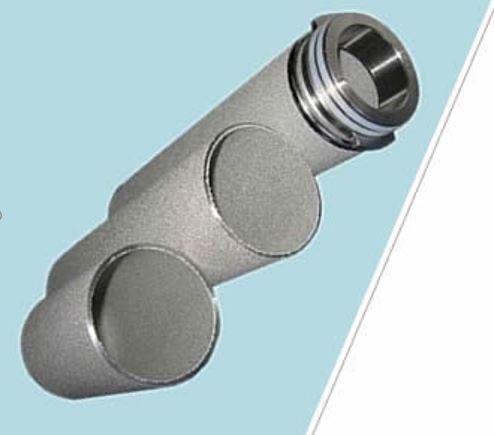
Sintered Filter
Places you can utilize this filter include;
- Steam filtration
- Water and oil filtration
- Chemical filtration
- Food and beverage filtration
- Filtration of viscous fluid
- Recovery of solid catalyst
- Filtration of gas and liquids at high temperature and pressure
- Decarburization filtration
- Filtration of corrosive fluid
- Filtration of oxidizing liquid
What is the Micron Rating for Sintered Mesh Filter?
The sintered mesh filter has a micron rating of 0.5-60
Clearly, there are many aspects you should consider when choosing sintered mesh filters.
At FilSon Filters, we offer a range of metal sintered filters depending on unique customer needs and requirements.
For any questions or inquiries about sintered mesh filters, contact FilSon Filters now.
